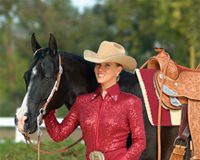Fear has safeguarded equines against predation for millennia, but it’s an unwelcome guest when you have plans in which your horse is too afraid to participate. The good news is he doesn’t have to be a slave to his autonomic impulses. He can learn to respond to frightening situations less reactively and more rationally, resulting in a safer more enjoyable horse for you.
Pay Attention:
Notice the moment your horse starts focusing on something he’s unsure about so you can nip the fight/flight response in the bud. Wide eyes, pursed lips, a tense neck, elevated head, flared nostrils, halting breathing, or ears stiffly pricked forward indicate he’s heading toward the deep end of the fear pool. Left unchecked, his brain will release chemicals that prepare his body for battle or hasty retreat, leaving you with a horse that is emotionally unstable and more risky to handle. The faster you can interrupt that process, the quicker and more easily you can help him calm down. The better you get at turning it off, the less your horse will depend in it as a survival tool, and the weaker the response will become.
- Relax:
You can be a calming influence for your horse, especially if he’s on edge. Your composure communicates confidence, competence, and invites your horse to follow your lead and depend on you for his well-being. Keeping your heart rate low, your breath even, and your posture neutral will give your horse comfort even when he’s feeling insecure. - Keep Your Distance:
Find the distance at which your horse can feel comfortable. Even a roaming pack of wolves won’t activate the fear response if they are too far away to been seen as a viable threat. The closer your horse is to the blanket hanging on the fence, shiny puddle of water, or whatever he finds alarming, the more intense his reaction will be. This cushion of protection allows your horse’s fight or flight instincts to recede. Once he’s calm, he can think rationally, process, and retain information. Sometimes having a chance to calmly observe what is troublesome from a safe distance is enough for your horse to realize it is not a danger. - Position Yourself between Your Horse and the Object of his Fear:
This step reduces emotional pressure on your horse, builds his confidence, and keeps you out of harm’s way. Forcing him to go ahead of you will make him feel alone, distrusting, and more anxious. If he’s pushed too far, he could become overloaded and his behavior could become more extreme and unpredictable. The ultimate goal is to replace reactivity with curiosity and interest, trademarks of confident behavior. Nevertheless, spooks happen. You’ll be safer if you’re not in the way should he try to escape. Another benefit of going first is that your horse can follow the leader, a natural herd behavior. Seeing you approach without a care in the world will inspire his confidence as well. If you’re riding when your horse’s fear takes hold, step off and work this step from the ground. - Redirect Your Horse’s Attention:
Once your horse is at a comfortable distance from the scary thing, give him a task that requires little cognitive effort and he can do easily. Discourage him from fixating on what’s bothering him and encourage him to focus on you. This can be accomplished by walking alongside you with his head straight (remember to lead from the side that’s closest to what’s frightening him), riding quietly within his comfort zone, longeing in a relaxed and balanced frame, or riding circles in proper alignment with his head long and low. Routine behaviors tell his brain everything is OK. This may result in the cause of his troubles fading into the environment and becoming a non-issue. Another possibility is that he becomes calm and confident enough to voluntarily move closer to the source of his fear. (If so watch carefully – if signs of distress to reappear return him to a less daunting distance.) If your horse is the highly reactive sort, any move toward to relaxation within proximity of his fear-trigger may require a great deal of effort and be a huge accomplishment. Asking any horse to give more than they are capable of giving pushes them him into fight/flight mode, promotes resistance, and is a setback to his progress and your relationship. If your horse is struggling, continue is confidence building work in a less challenging environment. - Reward, Reward, Reward!:
They should be bestowed lavishly anytime your horse makes an effort: big or small. Rewards tell your horse, “Yes! That’s right!” Rewards can be neck scratches, grazing time, a small treat, heartfelt praise, and a long or short break from his work. Letting your horse know he is doing well motivates him to do it again, is a huge boost to his confidence, and encourages collaborative behavior.
Dale Rudin is a CHA-certified riding instructor and clinician with a mindful and balanced approach to horsemanship and riding.
www.un-naturalhorsemanship.com






